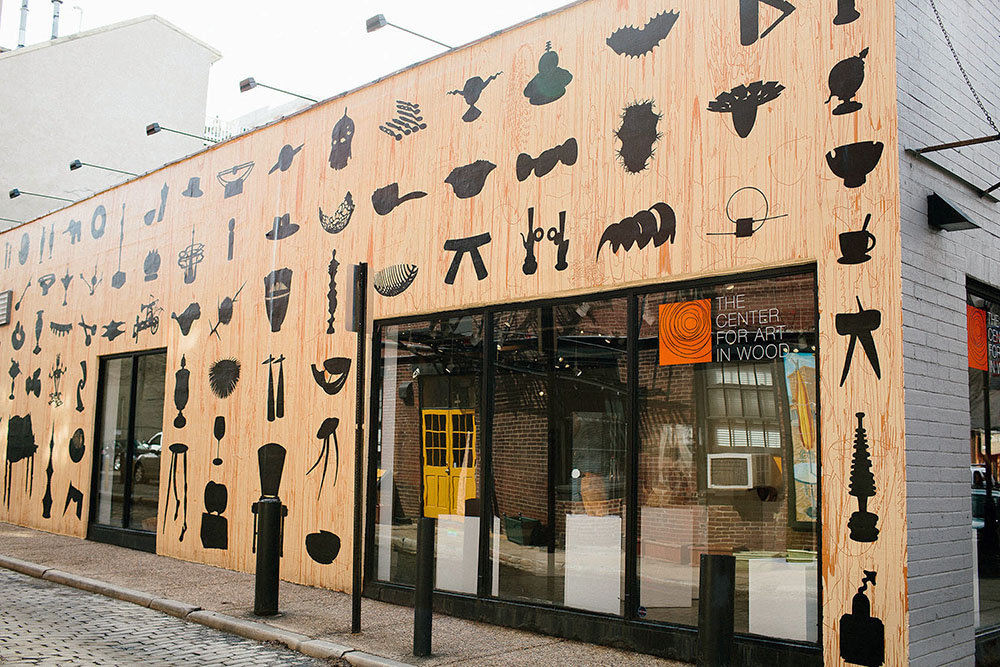 Over the last four decades, the Center for Art in Wood on North 3rd Street in Old City has enhanced the public’s understanding of contemporary art in wood through its collection, programming, exhibitions, and documentation. On January 30, the organization officially rebranded as the Museum for Art in Wood, in the wake of a transformative $10 million endowment from the Windgate Foundation to expand its mission, programs, and plans for growth.
Over the last four decades, the Center for Art in Wood on North 3rd Street in Old City has enhanced the public’s understanding of contemporary art in wood through its collection, programming, exhibitions, and documentation. On January 30, the organization officially rebranded as the Museum for Art in Wood, in the wake of a transformative $10 million endowment from the Windgate Foundation to expand its mission, programs, and plans for growth.
The museum launches with The Mashrabiya Project, an exhibition and shared-making project featuring new works by international artists from across the Islamic world. Hosted from March 3 to July 23, 2023, it includes interactive programming, a publication showcasing and exploring the significance of the wood-turned mashrabiya, and hybrid programming to encourage further public engagement and discussion.
“This organization has grown to become the world leader in building appreciation, awareness, and scholarship for art in wood,” said Jennifer-Navva Milliken, Museum for Art in Wood’s executive director and chief curator. “From its earliest days as the Wood Turning Center to its pivotal move to the current location in the cultural and historic heart of Philadelphia, this dynamic museum has hosted groundbreaking exhibitions, built a distinctive and important collection and archives, and opened its doors to the wonder of creativity in wood to visitors locally, regionally, and internationally.”
The organization emerged from biannual wood-turning symposiums and exhibitions held at the George School in Bucks County, PA, between 1976 and 1981. Wood-turning is a craft that involves using a lathe to rotate pieces of wood while an operator carves them into curved, axial shapes. The practice has been used for centuries to create utilitarian objects, including table legs, balusters, serving utensils, vessels, and architectural elements. Believed to have originated in ancient Egypt, this artisanal means of production is still practiced worldwide. However, in the latter part of the twentieth century, the lathe caught the interest of artists and sculptors, who began turning objects that represented formal or conceptual concerns rather than strictly functional.
The events were organized by wood-turning artist Albert LeCoff, his twin brother, real estate and commercial assets specialist Alan LeCoff, and woodworker and educator Palmer Sharpless. The trio is credited with spurring interest and expanding awareness around using wood-turning as a contemporary art form. In 1981, for the 10th and final wood-turning symposium, Albert LeCoff organized the national tour of the accompanying exhibition, The First North American Turned Object Show. This was the first wood-turning exhibition to tour North America, displayed at five different venues.
In 1986, the LeCoff brothers incorporated the Wood Turning Center as a 501(c)(3), with Albert taking the helm as executive director. He organized the first international exhibition of lathe-turned objects in 1988, titled the International Turned Objects Show. The Center continued to serve the global arts community and hosted two international wood-turning conferences.
For nearly 15 years, the center operated from Albert’s home in Germantown, Philadelphia, before moving to a public facility at 501 Vine Street in 2000. In 2011, the organization rebranded, changing its name to The Center for Art in Wood to reflect its evolution into a non-profit highlighting artists and research in the broader field of art in wood, and moved to its current location at 141 N. 3rd Street, in the heart of Philadelphia’s Old City arts and gallery district.
LeCoff retired in 2018, and Jennifer-Navva Milliken, a curator specializing in contemporary craft and design, was brought on to lead the vision and direction of the center in its next phase.
“We look forward to engaging the public with new and exciting opportunities and experiences under a name that encapsulates all we do,” says Milliken “The name change clarifies our work and mission, while the impact of the extraordinary and unprecedented support from the Windgate Foundation helps to stabilize our footing as we envision an exciting future. We can’t wait to welcome everyone to the Museum for Art in Wood.”
Visitors to the newly renamed museum can view one of the most extensive institutional collections of contemporary art in wood, with over 1,200 objects and rotating exhibitions on display, including turned objects, sculptures, studio furniture, installation, video, and more. Admission is free.
The museum also maintains an extensive archive of over 1,000 books, manuscripts, and journals preserving the history of wood-turning and woodworking, as well as 25,000 images and international artists’ records. The library provides a detailed look at the continuing evolution of these art forms within the broader field of contemporary art.
